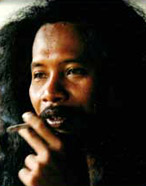 |
||
|---|---|---|
| CP Foundation | About CP Biennale | 2003 | 2005 | Contact Us | >||
           
|
||
|
Perhaps because he is so used to living according to Javanese rules and wisdom, he uses a lot of the old mind pattern of otak-atik gathuk (tinkering on things until they fit with each other), as he moves around the different territories of wayang (shadow puppets), Javanese myths, the Koran, and scientific discoveries. It is also important to keep this in mind as we see and explore Nasirun's works. Most of Nasirun's works are created using oil on canvas, employing the rough and wild techniques of impasto. The color composition is created right on the canvas as he lyrically expresses his thoughts about his personal experiences, putting them on his canvas. The figures are born from his wild and almost unplanned movements of his hands. Everything moves smoothly and simply on his canvas. One of Nasirun's visual hallmarks is the scratch he uses to "pierce" through the colors he has put on the canvas. He often jokes that the scratches are decorative scratches that will bring him fortunes. The scratches are often wild and often soft, often intricate and often winding - but they always appear as decorative patterns, indeed. This has to do with Nasirun's life history - he has once learned about crafts and has no wish to remove this aspect from his works. The dominating presence of red and black strengthens the atmosphere of the world he creates. The deformed figures also become Nasirun's strong visual hallmarks. He depicts humans that resemble shadow puppets; plants that appear to be eternally dry; animals (whether real or taken from mythologies) that seem to be more vicious and fearful; and other distorted objects - such as the moon, mountains, houses, trains, and chairs. All of these often bring us to new imaginations. Mike Susanto Born on October 1, 1965 in Cilacap. Studied at Indonesia Institute of The Arts (ISI), Yogyakarta. SELECTED SOLO EXHIBITIONS SELECTED GROUP EXHIBITIONS |
||
|
CP Foundation | About CP Biennale | 2003 | 2005 | Contact Us
Jl. Suryopranoto 67A, Jakarta 10160, Indonesia. ph. +62.21.3448126, 3853206 | fax. +62.21.3853203, 3853208 info@cp-foundation.org |
||
 In Nasirun's works one often finds borrowed idioms, chants, and teachings from his Islamic-Javanese cultural background. This is most easily seen in the texts he frequently inscribes in his works and in the titles he gives to the works. When I came to visit him and talk about his works, I was granted an "performance art" as Nasirun told me the story of his creative processes. Nasirun sang and offered me his thoughts about Islam by chanting some parts of the Koran every now and then. As he worked on his sketches, Nasirun also wrote, talked in the most exalted form of Javanese, and laughed from time to time. Nasirun's mind-frame works in the territory of Islamic-Javanese philosophy and way of life. He, for example, captures his memory about local mythical characters - such as nini thowong, jejadian, dhemit, and putrang aring - and molds them into the Islamic and contemporary culture. The results are stories that may seem absurd and difficult to be perceived with the pure logic of our rational minds. Even though he occasionally strays to other themes, he is always "forced" to go back and continue his meditations on his life as a Muslim Javanese.
In Nasirun's works one often finds borrowed idioms, chants, and teachings from his Islamic-Javanese cultural background. This is most easily seen in the texts he frequently inscribes in his works and in the titles he gives to the works. When I came to visit him and talk about his works, I was granted an "performance art" as Nasirun told me the story of his creative processes. Nasirun sang and offered me his thoughts about Islam by chanting some parts of the Koran every now and then. As he worked on his sketches, Nasirun also wrote, talked in the most exalted form of Javanese, and laughed from time to time. Nasirun's mind-frame works in the territory of Islamic-Javanese philosophy and way of life. He, for example, captures his memory about local mythical characters - such as nini thowong, jejadian, dhemit, and putrang aring - and molds them into the Islamic and contemporary culture. The results are stories that may seem absurd and difficult to be perceived with the pure logic of our rational minds. Even though he occasionally strays to other themes, he is always "forced" to go back and continue his meditations on his life as a Muslim Javanese.